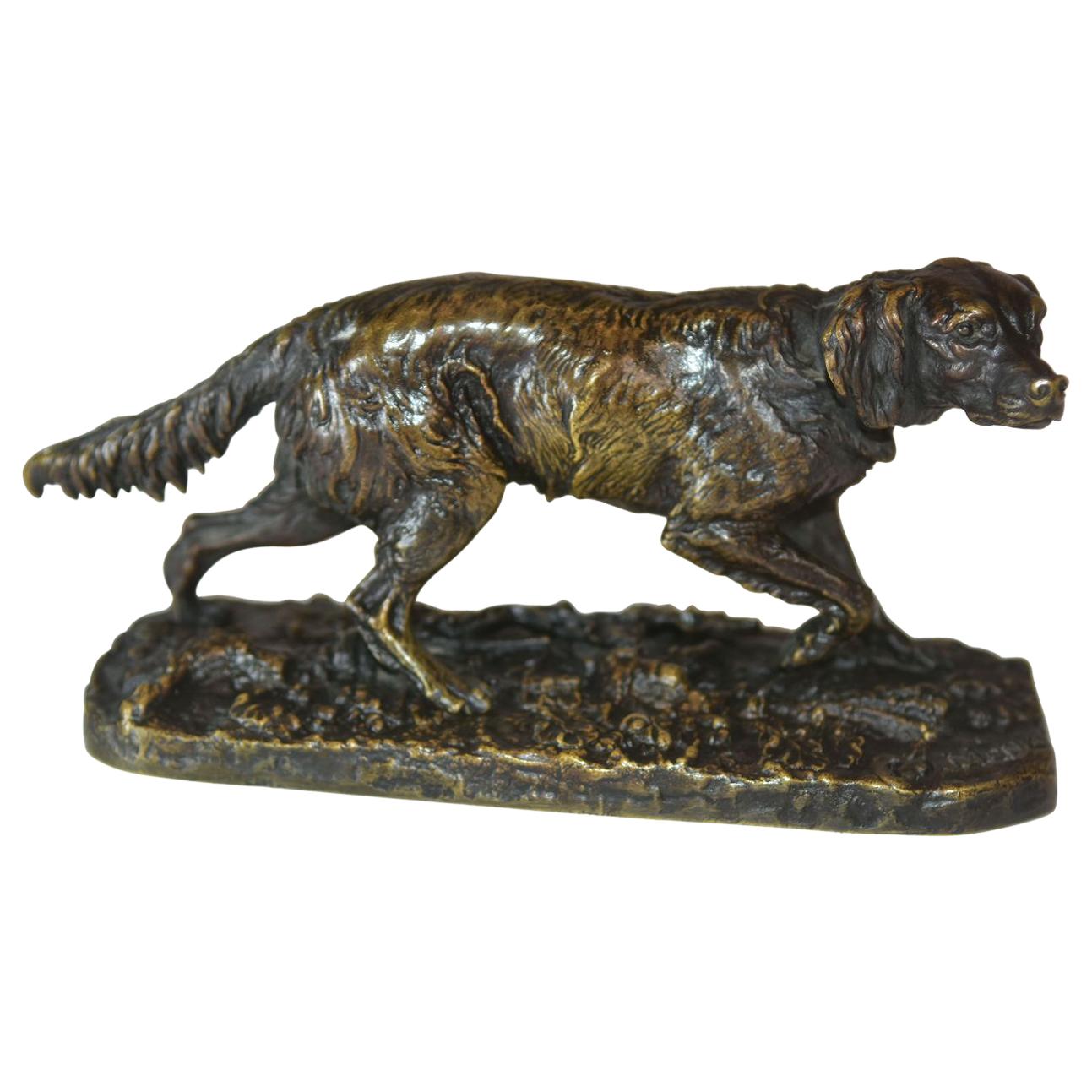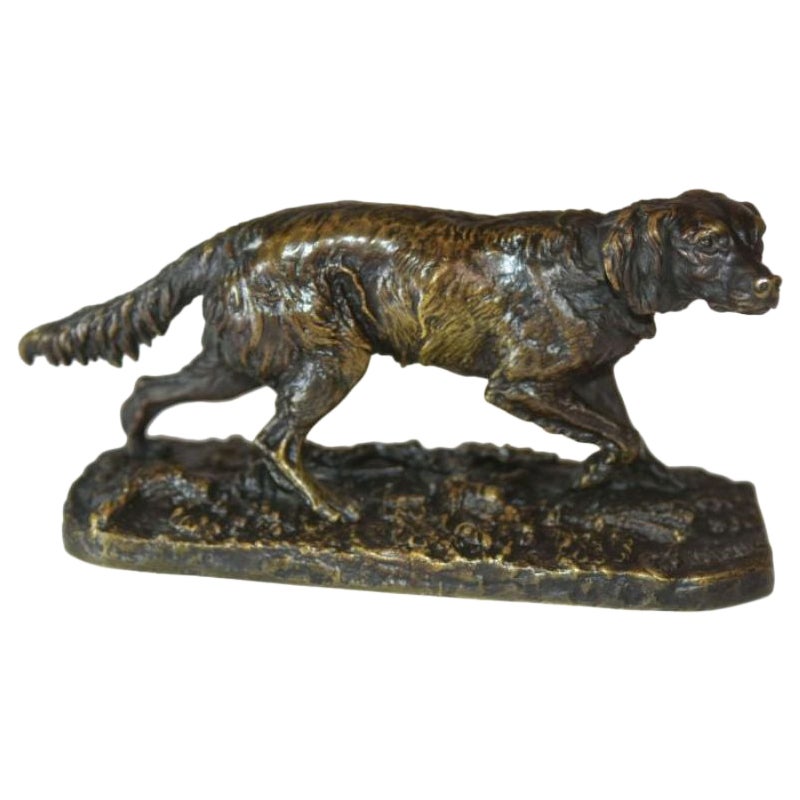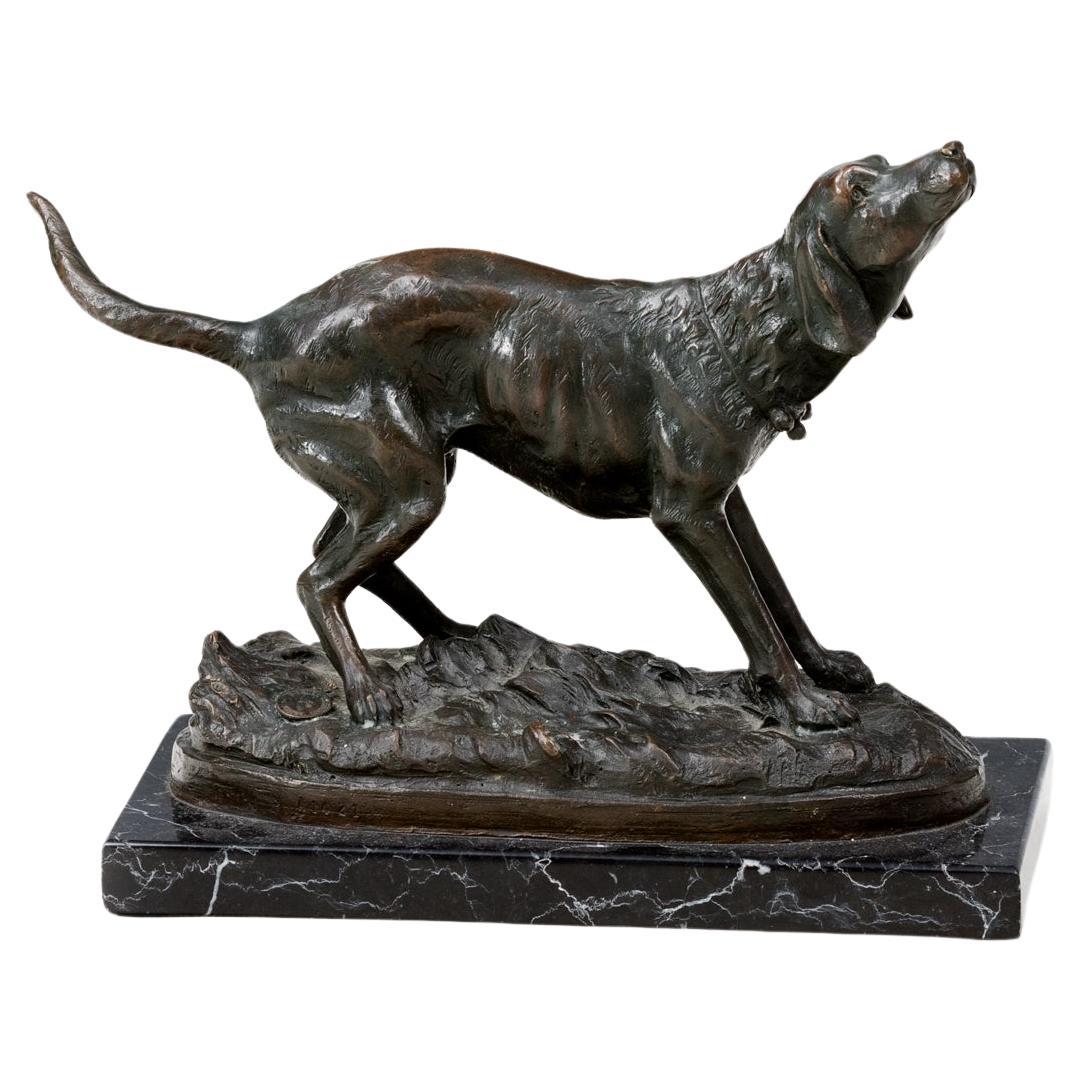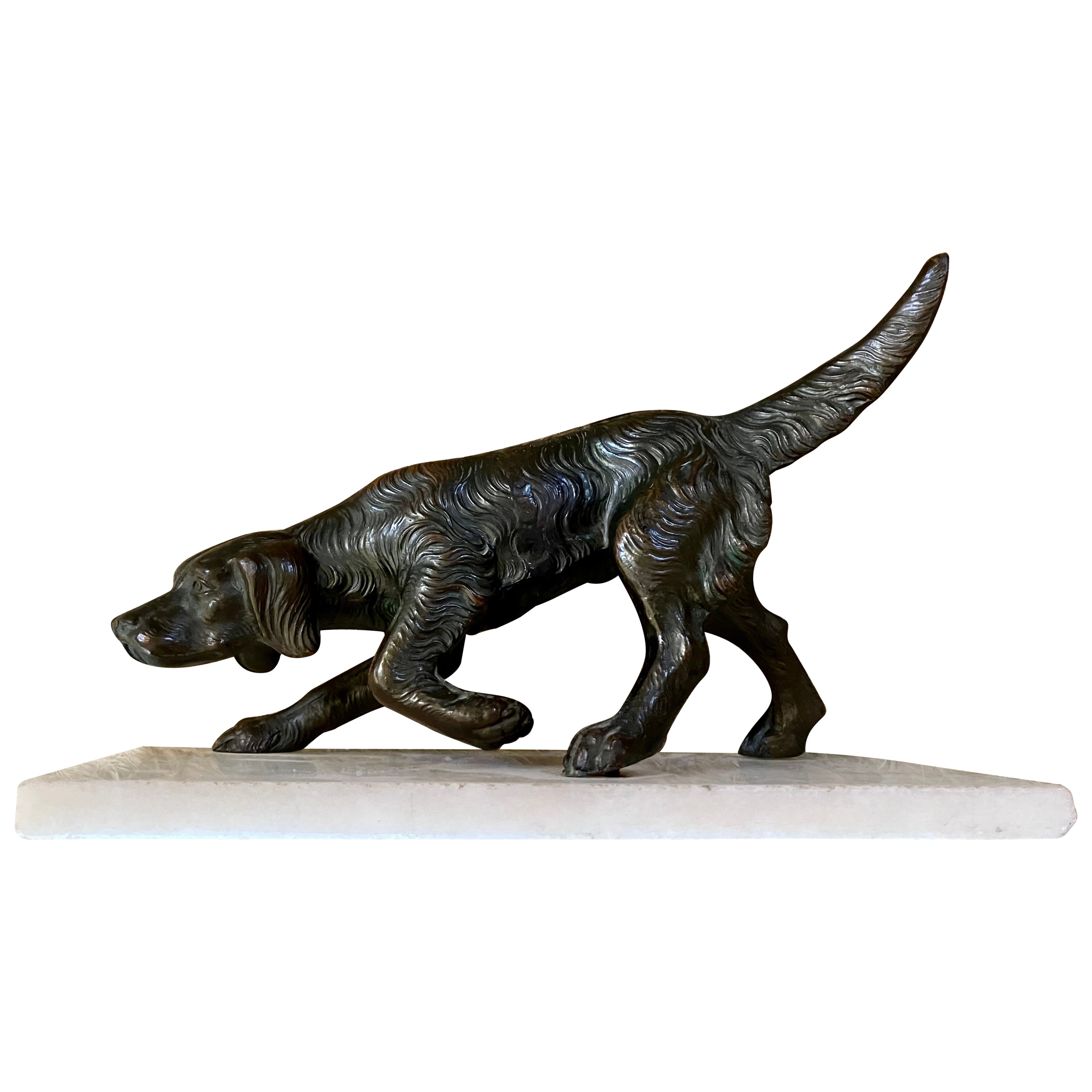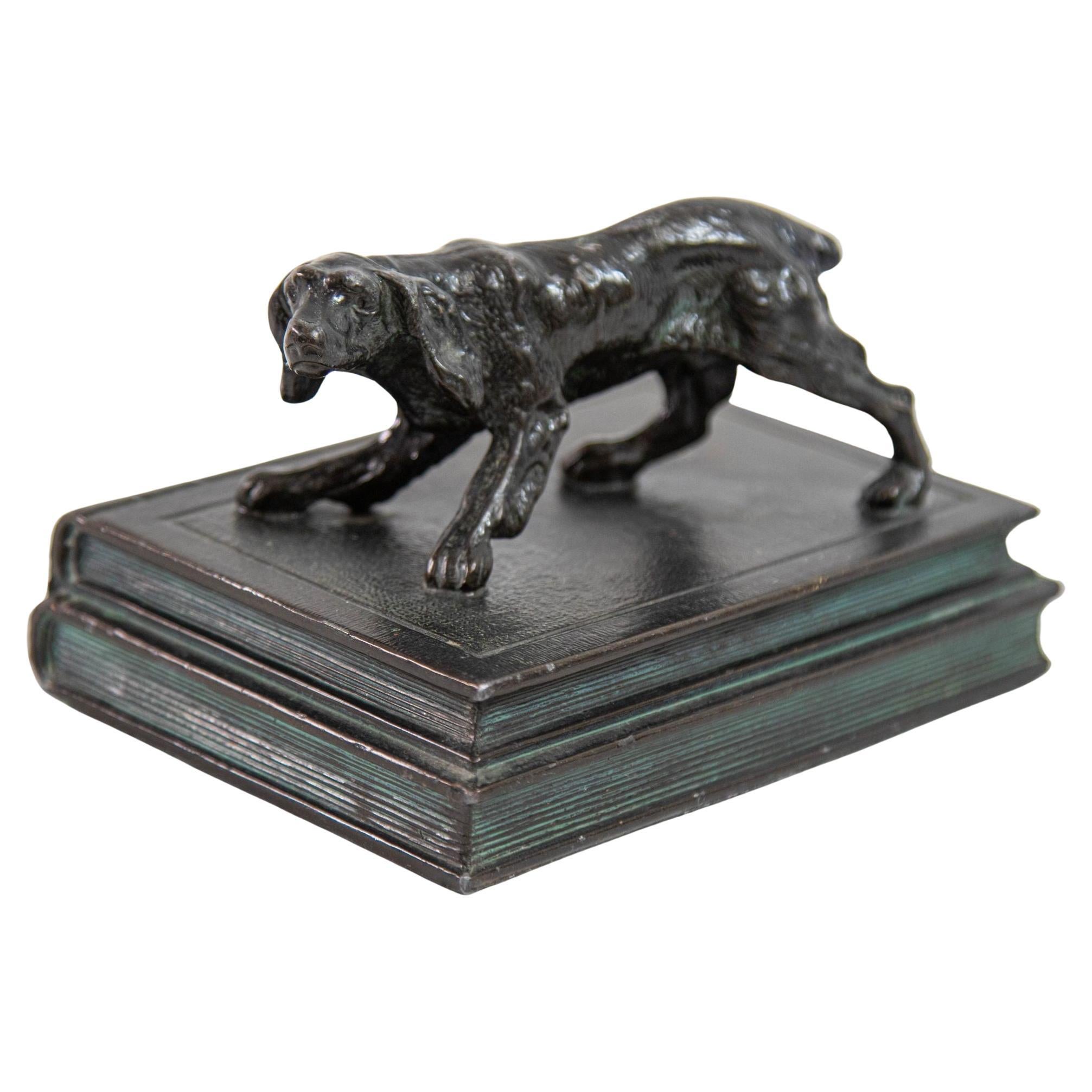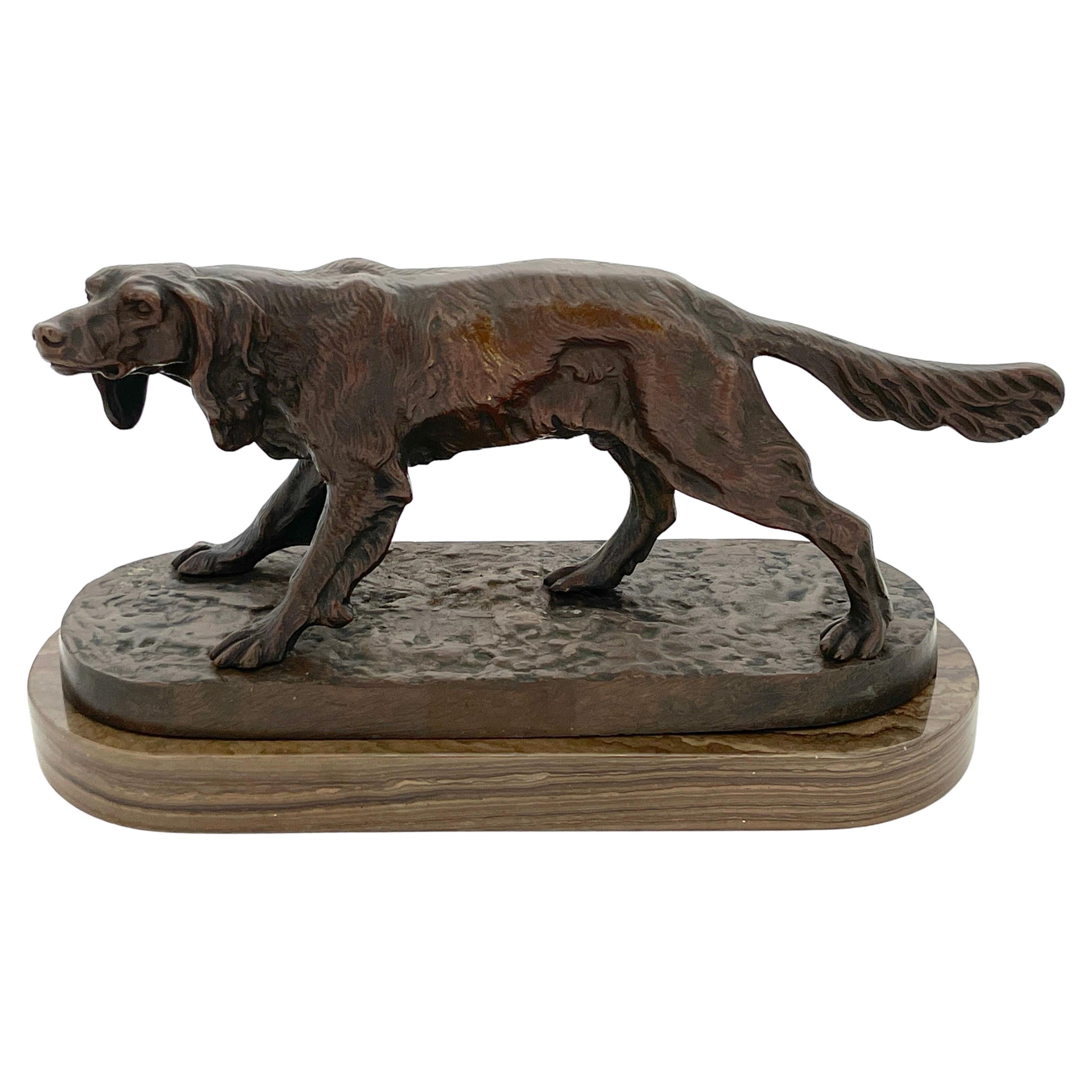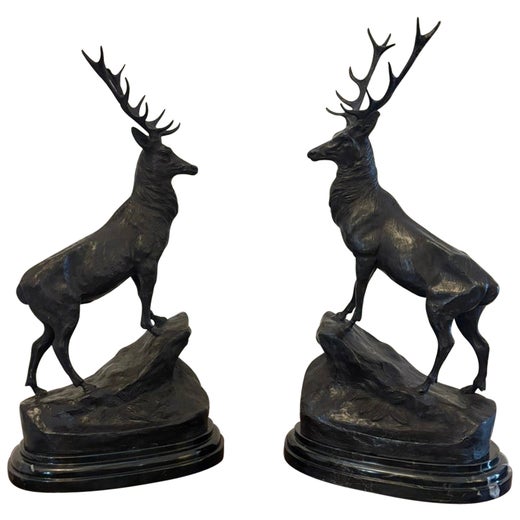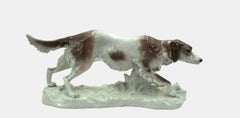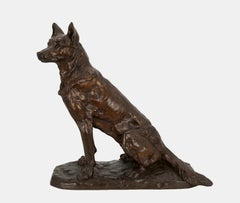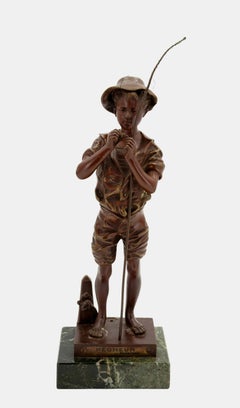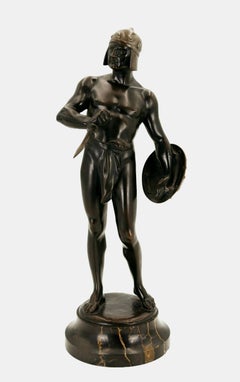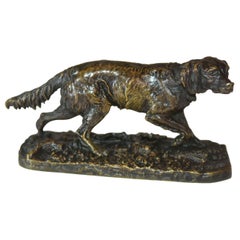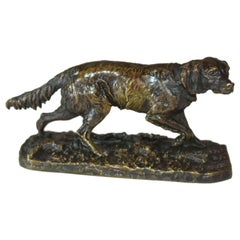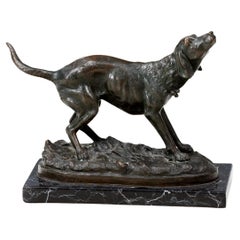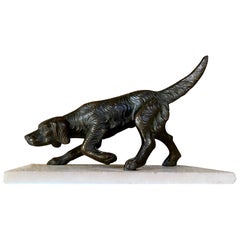Jules Moigniez (1835 Senlis - 1894 St-Martin-du-Tertre), Hunting dog on the prowl, around 1880. Dark patinated bronze with naturalistic terrain plinth, 16 cm (height) x 30 cm (length) x 13 cm (depth), weight 3.25 kg. Signed “J.[ules] MOIGNIEZ.” on the plinth.
- Occasionally bumped and rubbed in places, overall in good condition for its age
- Following the scent -
The hunting dog has picked up the scent. He is highly concentrated and his body is filled with inner tension, which is particularly evident in the raised tail. But also the slightly lowered head, the wrinkling of the neck, the pronounced tensing of the muscles and, not least, the strong-willed expression on the dog's face show that the hunting instinct has taken hold of the dog. The wrinkled nose gives the impression of hearing the sniffing, while the creeping movement seems to make little noise.
Jules Moigniez has the dog place each leg on its own stone on the terrain plinth. This gives him a pedestal that shows off the hunting movement and the naturalistically sculpted body. However, it is not the realistic outer appearance, but the masterfully depicted hunting instinct that makes the dog appear so alive. The dog has already placed its front paw on the stone under which the hare to be tracked down is hiding. In the next moment, the scent will lead the hunting animal there and the drama of nature will take its course. In this way, Jules Moigniez not only illustrates a dog on the prowl, but also depicts an entire hunting story that is focused on the moment of greatest tension - immediately before the discovery and killing of the prey.
About the artist
As the son of a gilder, Jules Moigniez was born with the delicate and precise workmanship that characterizes his work. In Paris, he studied sculpture under Paul Comoléra, whose depictions of birds influenced his work. He was also a student of François Rude, who created the relief "La Marseillaise" on the Arc de Triomphe in Paris.
His work as an independent artist was encouraged by his father, who purchased a foundry so that his son's work could be reproduced independently. Moigniez received his first artistic recognition with the plaster sculpture "Chicken Dog in Front of a Pheasant", which was presented at the 1955 Paris World's Fair. Cast in bronze, the work was acquired by the French government in 1859 and exhibited at the Château de Compiègne. In 1862, Moigniez was awarded a medal at the Great Exhibition in London and became internationally known. Between 1855 and 1892, he exhibited a total of thirty works at the Paris Salon.
His depictions of animals were extraordinary popular, particularly in Great Britain and later in the United States, because of their vivid effect. The animals are always depicted in an almost dramatic movement, in keeping with their nature, with Moigniez paying attention to every detail, including the design of the pedestals. Compared to the important animal sculptors who preceded him, Pierre-Jules Mêne and Antoine-Louis Barye, he created entire landscapes of events.
After a long illness, Moigniez ended his life at the age of 59.
GERMAN VERSION
Jules Moigniez (1835 Senlis - 1894 St-Martin-du-Tertre), Jagdhund auf der Pirsch, um 1880. Dunkel patinierte Bronze mit naturalistischer Terrainplinthe, 16 cm (Höhe) x 30 cm (Länge) x 13 cm (Tiefe), Gewicht 3,25 kg. Auf der Plinthe mit „J.[ules] MOIGNIEZ.“ signiert.
- vereinzelt bestoßen und stellenweise berieben, insgesamt in einem altersgemäß guten Zustand
- Der Fährte folgend -
Der Jagdhund hat Witterung aufgenommen. Er ist hochkonzentriert und der Körper von einer inneren Anspannung erfüllt, die besonders im hochgestellten Schwanz zum Ausdruck kommt. Aber auch der leicht gesenkte Kopf, die Falten des Halses, die ausgeprägte angespannte Muskulatur und nicht zuletzt die willensstarke Mimik verdeutlichen, dass der Hund ganz vom Jagdinstinkt ergriffen worden ist. Die krausgezogene Nase vermittelt geradewegs den Eindruck, das Schnüffeln zu hören, während die schleichende Bewegung hingegen kaum Geräusche zu verursachen scheint.
Jules Moigniez lässt den Hund jedes Bein auf einen eigenen Stein der Terrainplinthe setzen. Dadurch erhält er ein Postament, welches die Jagdbewegung und den naturalistisch durchgeformten Körper zur Schau stellt. Es ist aber nicht die wirklichkeitsgetreue äußere Erscheinung, sondern der meisterhaft dargestellte Jagdtrieb, der den Hund derartig lebendig erscheinen lässt.
Der Hund hat seine Vorderpfote bereits auf den Stein gesetzt, unter dem sich der aufzuspürende Hase verbirgt. Im nächsten Moment wird die Fährte das Jagdtier dorthin führen und das Drama der Natur seinen Lauf nehmen. Damit veranschaulicht Jules Moigniez nicht einzig einen Hund auf der Pirsch, sondern schildert eine ganz Jagdgeschichte, die auf den Moment der höchsten Spannung – unmittelbar vor dem Entdecken und Erlegen der Beute – zugespitzt ist.
zum Künstler
Als Sohn eines Vergolders war Jules Moigniez das feinteilige und präzise Arbeiten, welches seine Werke auszeichnen, bereits in die Wiege gelegt. In Paris studierte er bei Paul Comoléra Bildhauerei, dessen Vogeldarstellungen sein Schaffen prägten. Zudem war er Schüler von François Rude, der das Relief „La Marseillaise“ am Pariser Arc de Triomphe angefertigt hat.
Sein Wirken als selbständiger Künstler wurde von seinem Vater gefördert, der eine Gießerei erwarb, damit die Werke des Sohnes unabhängig vervielfältigt werden konnten. Die auf der Pariser Weltausstellung von 1955 präsentierte Gipsplastik, Hühnerhund vor einem Fasan, verschaffte Moigniez erste künstlerische Anerkennung. In Bronze gegossen wurde das Werk 1859 von der Französischen Regierung erworben und im Schloss Compiègne gezeigt. 1862 wurde Moigniez auf der Londoner Weltausstellung mit einer Medaille geehrt und international bekannt. Zwischen 1855 und 1892 stellte er insgesamt dreißig Werke im Pariser Salon aus.
Seine Tierdarstellungen erfreuten sich aufgrund ihrer Lebendigkeitswirkung insbesondere in Großbritannien und später auch in den Vereinigten Staaten einer außerordentlichen Beliebtheit. Stets sind die Tiere in einer ihrem Naturell entsprechenden, beinahe dramatischen Bewegtheit veranschaulicht, wobei Moigniez jedes Detail authentisch durchformt, was auch für die Gestaltung der Plinthen gilt. Im Vergleich mit den bedeutenden ihm vorausgehenden Tierplastikern, Pierre-Jules Mêne und Antoine-Louis Barye, kreiert er ganze Ereignislandschaften.
Nach langer Krankheit beendet Moigniez mit 59 Jahren sein Leben.

